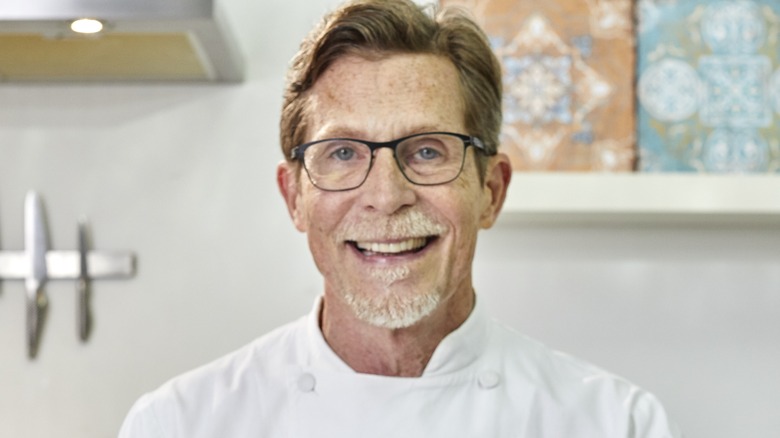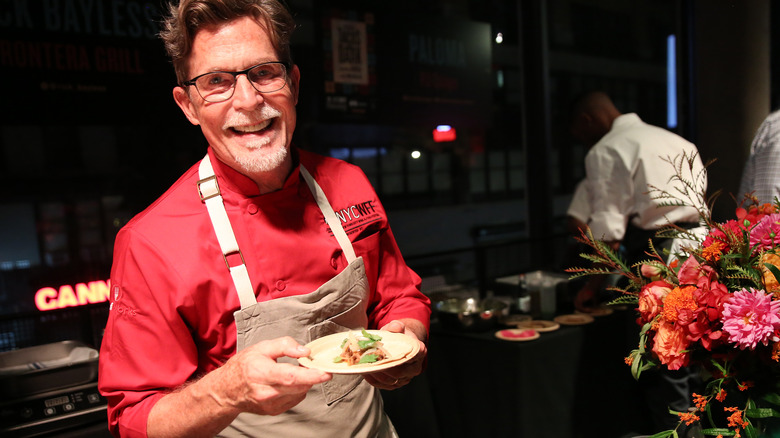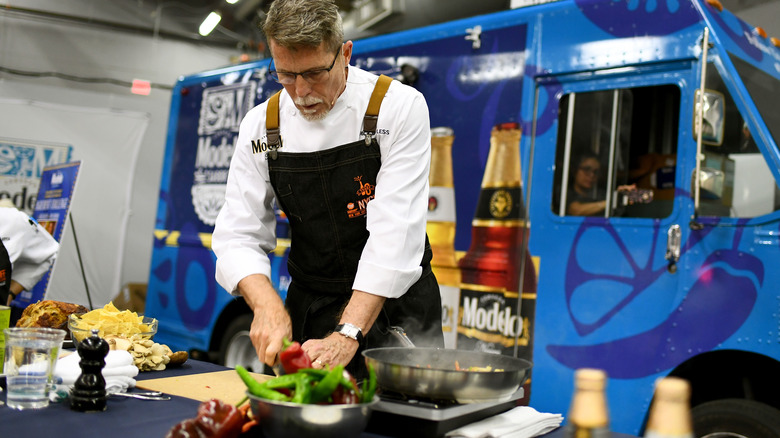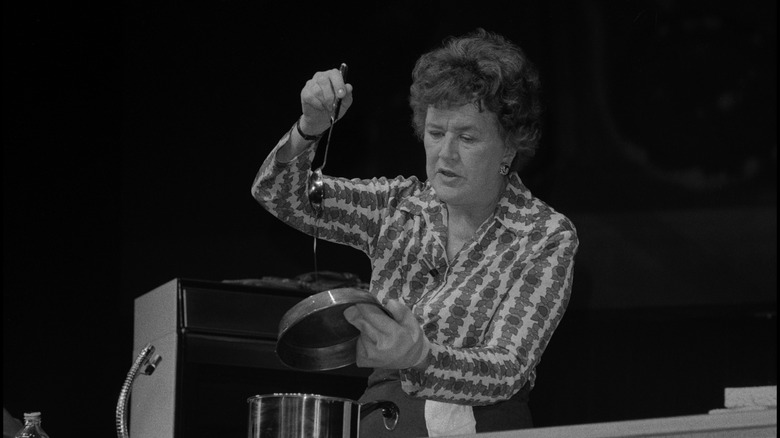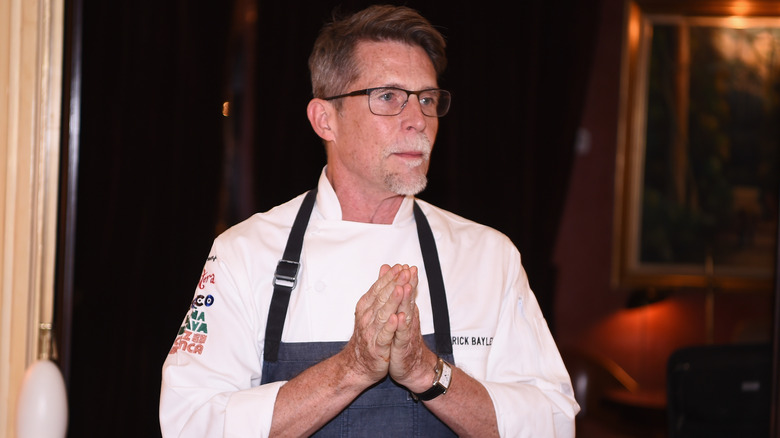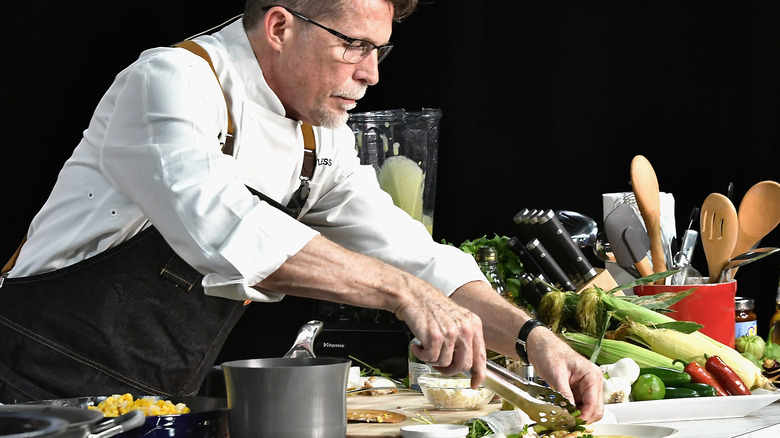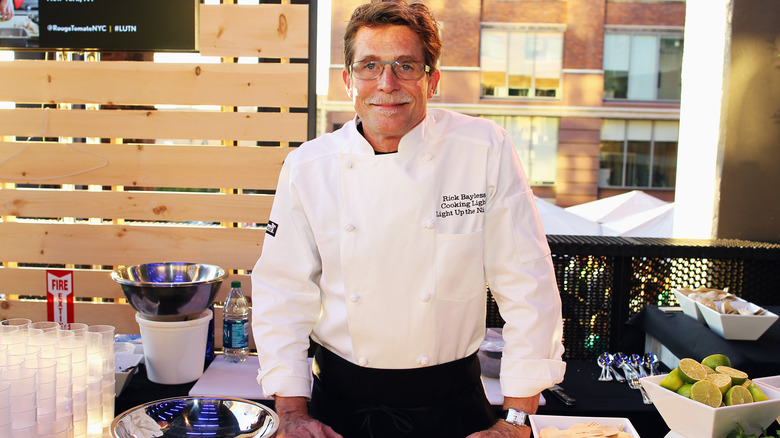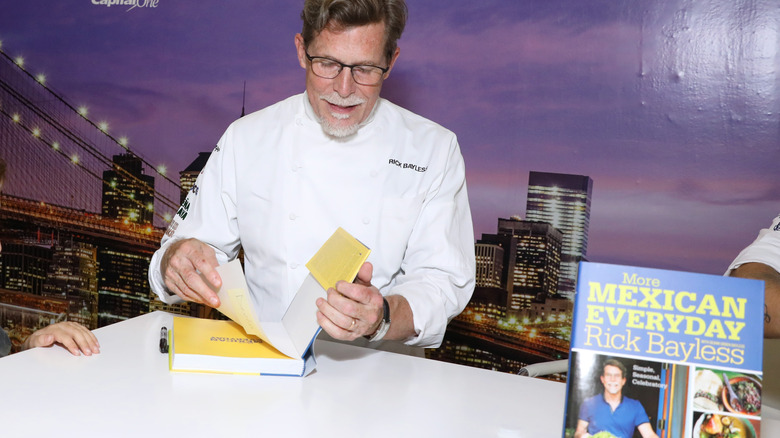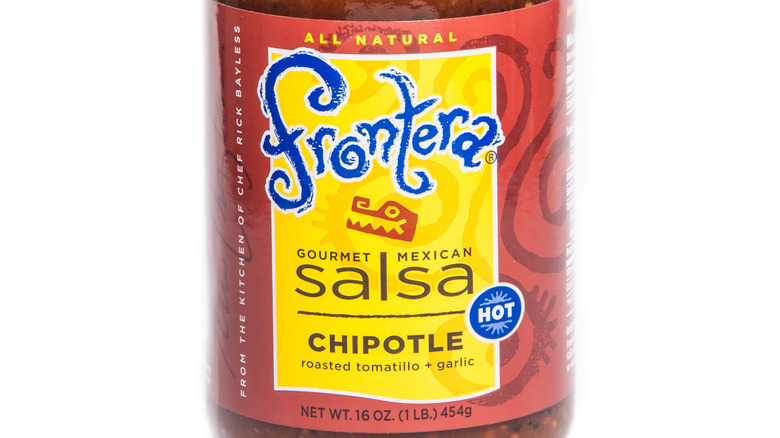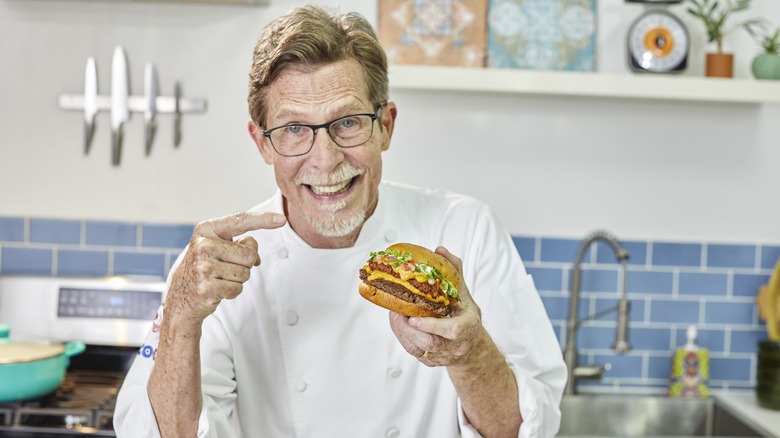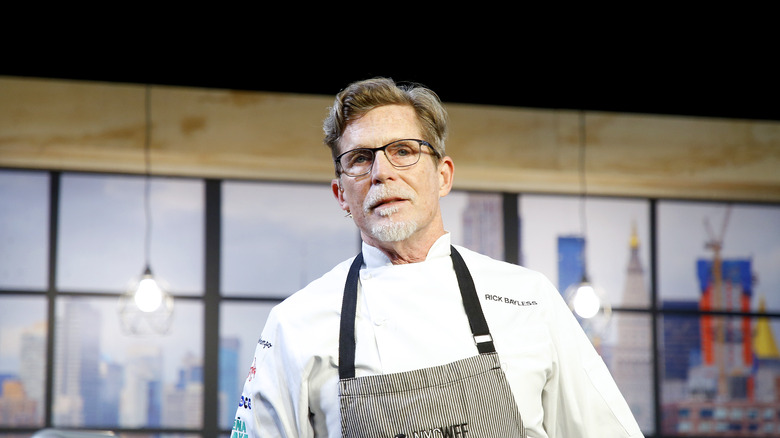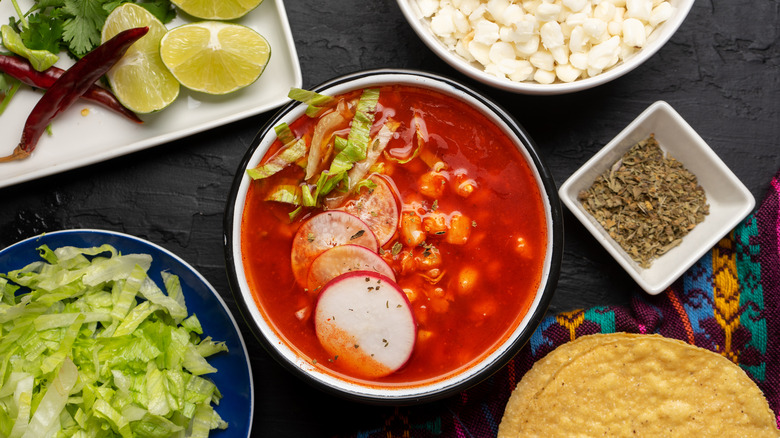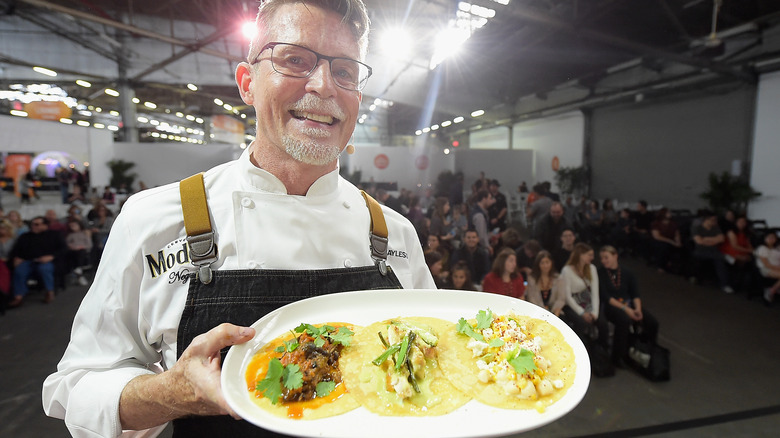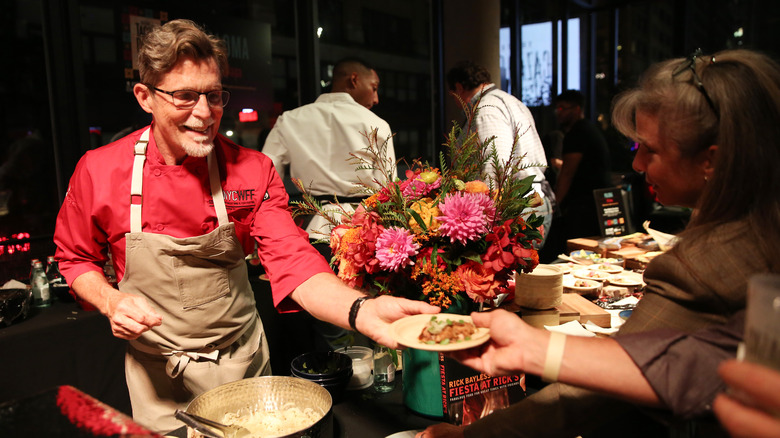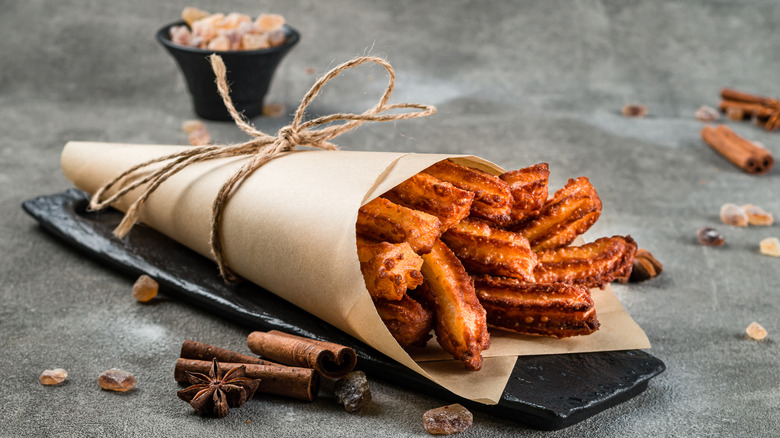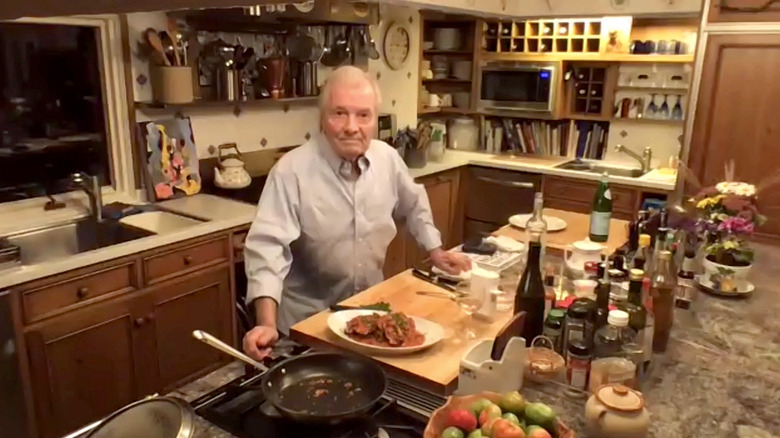Chef Rick Bayless Talks Smashburgers, Authentic Mexican Food, And Creating A Cookbook - Exclusive Interview
Many people find their life plans changing right at the time they expect to be hitting their stride. Studying for a specific college degree may reveal a lack of passion for a given field, or a first job out of school may lead to a complete re-think of one's planned professional path. Other people find their calling later on in life. Having children may spark a love of teaching that leads to a career shift toward education, or perhaps the free time gained in retirement may lead to a third act as a writer, photographer, or amateur historian.
Then, you have those people who knew from a young age what they wanted to do with their lives and actually did just that. It's in this rarefied category that we find chef Rick Bayless, a man for whom food has always played an absolutely central role. Cooking and serving dishes, crafting meals, learning about food and about culture through the culinary lens — these are not things Bayless had to put his mind to, because his mind has always been there. During an exclusive interview with Mashed, the chef celebrated for his cooking — and especially for his work with authentic Mexican cuisine — took us back to the start of his food journey, one that has taken him to many parts of the globe, but more importantly has let him bring global tastes to American palates. It all started with a quintessentially American cuisine: barbecue.
For Rick Bayless, the restaurant was always home
Did you start cooking from a young age, or did you come to food as you grew up?
I started cooking from a very early age and I loved it. I grew up in a restaurant, it was our family's restaurant. I grew up in that.
Who were your earliest culinary influences?
Well, I grew up with a family that was all oriented toward food. Everybody in my family had restaurants at some point, and so we came from that world. I was raised in an environment where we talked about food all the time. My grandmother, she was a really great host. She loved having big parties, and she would cook stuff, and then she had three kids under five [years old] during the Depression, and so she learned how to can stuff and to do all kinds of preservation stuff. She still did that when I was a little kid, and you need lots of hands to do that. I was one of the pairs of hands that she would always say yes to, so I cooked since I was a little kid. It was just part of my world.
I grew up in a place where there were professional cooks all around me, and I liked hanging out with them, and they started teaching me from very early age. I wouldn't say that it was just one person, but it was being in that incredible environment of cooking all the time that was my biggest inspiration.
The chef's early culinary cultural exploration
What were the types of cuisines that you were exposed to the most in those formative years?
Well, I grew up in a barbecue restaurant, so barbecue was the main thing. My grandmother was a really good Southern cook, and she weaned me on those kinds of flavors. Between barbecue and Southern food, I would say those were my biggest experiences, but I was always interested in exploring other things. I grew up with Tex-Mex too, and we ate it all the time. It was what everybody did. You didn't ask people: "Oh, do you like Mexican food?" Everybody just ate Tex-Mex food, which is very different than the food that I do now, but at least it borders on it. I had the opportunity to get a little bit acquainted with some Mexican flavors when I was a kid — at least, I knew what a tortilla was — but Tex-Mex food really has so much to do with this red chili gravy that's made from chili powder, which doesn't even exist in Mexico.
I had that as part of my influences, but growing up, I spent tons of time in the summer down at our local public library, which had all kinds of international cookbooks. I would check those things out and study them, and then attempt to make a meal from them. Finding the ingredients was hard [while] growing up in Oklahoma City in the '60s, but I still worked hard to try to create stuff, just to explore another culture through food. I can articulate that now much more than I could when I was ten, but that's what I was doing — I was really fascinated by cultures. I understood very much that our culture in the town I grew up in really expressed itself through barbecue, because that's what we had and I grew up in a barbecue restaurant. I understood the relationship between culture and food from a very early age.
Today, Rick Bayless loves foods from far and wide
Beyond the Mexican food for which you're known today, what are your favorite cuisines?
I tend to go for [everything]. I'm one of those people that is a total omnivore. I love everything ... there's so many cuisines in the world and to say that you even know one, even moderately proficiently, means you've spent years and years cooking that, and getting to know the ingredients, and all that sort of stuff. I cook a lot, and I cook a lot of different things. I tend to love to explore cuisines that have a lot of spicing going on. Indian and Thai cuisines are two that I spend a fair amount of time getting to know, just because their way of spicing is so different than Mexico's ways of spicing. I'm kind of interested in learning more about all of that, but I only get to do it once a week, maybe, so it's a slow-going thing.
I love to explore the grocery stores and get to know other things. I also cook Japanese food and Chinese food, and love all that stuff.
How Rick Bayless came to Mexican cooking
What led you to Mexican cooking?
I grew up watching Julia Child in her first series of television shows on public television, and I just fell in love with technique. Actually, at one point in my life, when I was cooking professionally, I was only cooking French food. I had lived in Mexico, had a degree in Latin American studies, and for my own love, I had learned to cook some Mexican stuff, but I was professionally a pastry chef, mostly, that had specialized in French food because I was really taken with all the technique that it had to offer, because it's the most advanced in terms of those kinds of techniques, and still the basis of the professional kitchens. All the language still comes from French.
Then some people started asking me to teach classes in how to make Mexican food, so I had to delve more deeply into it. Even though I had lived in Mexico and gone to school in Mexico, I had to learn more about it. Then, all of a sudden, I thought, "No, this is where really my heart is!" I've still continued to love French food as time has gone on, not so much for the flavor as for the technique that it teaches me. It's technique that, like with any craft, you just have to keep doing it over and over again. I do cook a fair amount of French food too.
Rick Bayless talks learning to cook on camera
What were some of your experiences when you were cooking for the camera like?
My first experiences were frightening. Before I started actually doing 30 minute shows on public television and such, which I started doing toward the end of the '70s, I had done a whole lot of cooking on camera during the long format news shows in the morning, local news shows, and I had become a regular on one. I was living in Ann Arbor, Michigan, and one of the Detroit stations had me on a lot because one of the things that I knew how to do — I don't know, it just came naturally to me — was to cook to time. Timing is everything.
When I did my first series of shows for public television, we shot the whole shows live to tape. There was no editing. I would start, and then I think in that situation, it was 26 minutes later, I would be completely finished with three dishes in front of me. There were no edits. There was no nothing. We had three cameras, and there was a guy in a switching booth that was just up there choosing what he thought was the best angle for it. That was the show, and those were scary, because I had to talk for 27 minutes and cook for 27 minutes.
The difference between early cooking shows and today
How has cooking on TV changed over the decades?
There was never that thing that we all know now in cooking shows, where there's the cutaway to something that's actually shot later, after the show is done. If you go down a wrong path in the words that you're saying, you can just stop and say, "Oh, let's do that again," but we couldn't do that at all during the early days. Everything, including all those Julia Child shows, they were all shot live to tape.
That fake thing that happens, where people get halfway through a dish and then all of a sudden say, "And this is the way it comes out," and they present the dish to you, and you think, "That doesn't look anything like the dish that was just started over there!" We didn't do any of that. I cooked everything live. If something had to simmer for a while or bake or whatever, I would have another one at exactly that stage. I was always really big on continuity, that it should look exactly like the one that I had put in there.
Cooking that way is really, really nerve wracking because you have to incorporate everything into what you're doing. There's no opportunity to ... if you drop something on the floor, then you have to make that part of what you're doing. It's a lot like working improv in a way, because, yes, you have planned it all out, but it may not all go that way. You have to know your equipment really well, so that if you put something on a burner, you have to know how hot that burner exactly is so that it doesn't scorch on the bottom. If you're saying you're browning it, that you flip over whatever it is that's in the pan and it looks brown. It doesn't look blonde. That's my memory of those first times is how incredibly stressful it was to cook that way. Nowadays, we have much more luxury.
The most fun Rick Bayless has had cooking on TV
What is some of the most fun you've had cooking on TV?
Well, I would say being on "Top Chef Masters," that's a completely different way of thinking about cooking on TV, because you're always timed, and you have to have your plans exactly laid out right so that you can get through whatever you have to do. Even if it might not be what we would call the best technique, if you got 20 minutes to make a dish, then you're going to cut every corner you know how to cut and still turn out something that's delicious. That was both challenging and, looking back on it, kind of fun because I got a chance to cook in many different styles. I had to really dig deep to say, "Oh, wait a second!"
I remember on one of the examples with my absolute very first challenge, and it was a quick fire challenge and we had 20 minutes to make it. I looked up at the clock and I thought, "Oh my God, I don't even have time to cook my sauce!" It was a sauce that was going to go in a blender, and I thought: "Oh, I read in the manual to the Vitamix blender that if you just leave the blender on high for a while, it'll heat up the contents, and you can actually cook that way." I cooked my sauce in the blender jar and made my time. So those were kind of exhilarating and fun things to do that really did make that kind of an interesting experience.
The opportunity, like with my long running show, "Mexico One Plate at a Time," of being able to cook in odd places all around Mexico, on beaches and places like that, those were really fun. One time, I did an hors d'oeuvres spread, like an appetizer spread — I went to a market in Acapulco, and then I went to the hotel that we were staying at, and they had the tiniest little kitchenette there. I made a whole bunch of appetizers that people could enjoy with just the toaster oven that was there. It was really fun to be able to play around with those kinds of challenges.
How Rick Bayless crafts his cookbooks
How do you plan the process of creating a cookbook? What informs the overall theme, and how do you choose which recipes you're going to include and which simply have to be left out?
Well, that's an art, and I'm not sure that you can really say exactly. I can't really boil that down to a couple of phrases. First of all, you have to come up with a theme for the book. And that theme, well, the American public goes in waves. Sometimes they're looking for something that is single subject, so it's about one thing, basically, great egg dishes for instance, or something like that. Other times, they only want big books. I've had a tendency to write big books, but then my editor, my longtime editor, she asked me to do something, because a lot of my recipes are very classic and it's like the things you would do for Thanksgiving dinner. They're time consuming to make, and she said, "So tell me, what could you do if I told you that you had to cook something quickly? How would you do it?"
I thought, "Oh, well, that's sort of like what a lot of Mexican moms have to do all the time. And so why don't I just bring together all of my knowledge about how people make some of these things in their homes when they're cooking quickly, plus all the experience that I have had in restaurant kitchens, when you're behind and you figure out a faster way to do something, and bring that to some of these classic flavors of the Mexican kitchen?" I wrote the book "Mexican Everyday," and then I actually ended up doing a second volume to that, "More Mexican Everyday," because that's something people could use a lot.
Sometimes, you respond to what we would call market trends. It's unfortunate that "quick and easy" has become sort of everybody wants. Even people that are writing big books will oftentimes put "quick and easy" in their subtitles just to sell books, even if they're not so much "quick and easy" ... I'm much more of a [culturally]-oriented person. All of my books have been about Mexican culinary culture and how the culture is reflected in the food. I tell stories about that kind of stuff a lot, and I think that's the way you would best characterize my stuff.
Bayless on his Frontera salsas and sauces
Do you have a favorite Frontera salsa and a favorite sauce, or is that like picking one of your kids that you like the most?
It is like picking the [favorite] kid... but with the salsas, we make the salsas the way they would be made in Mexico, especially in Central and Southern. We do roasted tomatoes, roasted tomatillos. We work with the whole chili pods when we make stuff. When you eat our chipotle salsa that we have, which is the biggest selling of all of the salsas, you [realize], "Oh, that's made with tomatillos, it's not made with tomatoes." It's got at a different flavor profile than most everybody else's tomatilllo salsa. We roast everything, so it's got more complexity and that sort of thing. If you told me I had to bring one of our jarred salsas to your party, I would probably bring that one because I think it really does give you a lot of, again, culture, because we cook in a certain way that reflects culture, but it also is super delicious and more complex than most people's salsas.
The sauces that we have in the pouches, they're all super good, but the one that I always have on my shelf at home, because it takes more time to make it from scratch than all the rest of them, is the one that's called the red enchilada sauce. I love using that. We don't use it in our Clark Street restaurants, but we [use it in our] place at Disney, and so we actually use that as a base to a couple of sauces that we do there. We have these fast casual places that are called Tortazo, and [for] those, we use the red chili enchilada sauce as a base to some of the things that we do there, because it's super well made, and starting with the dried chili pods and all that stuff is time consuming.
Why the chef partnered with Smashburger
Why did you choose to partner with Smashburger to create a new menu item? Did it seem like an immediate fit to you?
I will tell you couple of things. It was actually Smashburger that reached out to me through a mutual friend. Carl Bachmann, who's the president of Smashburger, had come up with this idea of possibly doing a collaboration to be able to be able to raise funds for a charity. He reached out to me and said, "Could we talk about this? Would you be interested in it?" I have a very, very active philanthropic side of our businesses, and we have a couple of foundations that we have, and then we also raise a lot of money for other people's foundations. I said, "Oh yeah, if you're talking real money here to go to some of the charities that we support, that would be a really fascinating thing for me." But then, I had to figure out whether or not we could do something that would represent the quality that we work with.
I said, "The whole idea sounds really good to me, but we got to figure out now if we can produce a burger that I can put my name on. Okay?" Their R&D team came here, and we worked back and forth on a few things. To tell you the truth I was, and some of my staff will say the same thing, we were so impressed with the quality of the ingredients they brought us to work with that we thought, "Oh, this is sort of a slam dunk, because it's going to both help our charities a lot, and it's also just an absolutely delicious burger."
I have done some consulting work with a few of the other quick service places, and it was just about money and about the getting the cheapest product that they could work with. That was not my experience with Smashburger. It was really good quality stuff. They would always bring more product than what we needed when we were doing our testing, which my staff here at our restaurants on Clark Street was very appreciative of, because they loved those burgers, and so we would make them up for the whole staff. They were saying, "When are they going to come back and do more burgers with us?" It was a fun and actually very easy collaboration and we ended up with something that was just a great product.
The chef's advice for home cooks
What are a few tips you have for home cooks who want to improve their cooking? And what are common mistakes that amateur chefs make that they should try to avoid?
Two things I will say right away, and first is that most people don't use enough heat. They always wonder why things taste so good in restaurants. It's because we're not afraid of heat. A lot of people put pans on low fire, or they put it on medium when they should have put it on high. I know a lot of home cooks that would never, ever put a pan on high heat, but if you want to get that beautiful, rich brown crust, you got to use heat. So, number one thing is to not be afraid of heat, to be able to play back and forth with it. I also say that a lot of people have lightweight cookware, which tends to burn rather than brown a lot of times. I always tell everybody what you really, really need in your kitchen is a 12-inch cast iron skillet, because that will hold heat. You can heat it up slowly over a period of time, but it will hold heat, and it'll brown things in an incredibly beautiful way. Heat and the proper equipment to work with that heat, I would say is my first and foremost recommendation to home cooks.
The second one is to taste your food and season it with salt, because lots of people will just simply take a salt shaker, sprinkle it over a dish and say: "It's been salted." Well, yeah, you did sprinkle a little salt in there, but that doesn't mean the dish is salted. So what I always say is taste it. Taste it and add some salt. And then taste it again and add some more salt if you feel like it's needed. Watch the transformation of the food over a period that you're adding a little bit more and a little bit more. I think a lot of people are just so afraid that the worst thing that you can do in the world is to over salt the dish. Everyone under salts the dish, and then it's underwhelming. I always say that probably the thing that differentiates a home cook from a professional cook is surety of salting, because you have to get everything to the place where all the flavors come out, and if you don't add enough salt, then they won't come out.
Those two things, the fire and the salt thing, I think are the two biggest things. The other thing I would say is have a real knife in your kitchen. That would be something like anywhere from a six- to ten-inch chef's knife, and learn the absolute basic knife skills. You can find tutorials on YouTube and learn them, because that is what will make it safe for you in the kitchen and it will also make everything go so much faster for you.
Chef Rick Bayless on what Americans misunderstand about Mexican food
What are a few common American misconceptions about Mexican food?
That it's Tex-Mex food covered with sour cream and guacamole. That's not Mexican food at all. Mexican food is incredibly varied and very regional. And so the food, say, in the Yucatan Peninsula tastes nothing like the food in Mexico City. It's a very complex cuisine that has to do with all of these long cooked sauces. They're called moles or adobos, and those are really the essence of the cuisine, whereas if you go to a Tex-Mex restaurant, you probably won't see any of those things on the menu, because Tex-Mex food tends to be a little simpler. It tends to be a little bit more focused on lots of fresh garnishes and stuff on top of things.
The most interesting thing is that Mexican food doesn't use much cumin, and Tex-Mex food uses tons of cumin. In fact, chili powder has got a huge amount of cumin in it, so when people from Mexico taste that, they go,: "Whoa, what happened to the food? Why did you put all that cumin in there?" It's a very essential part of Mexican-American. Some people would say, "That's my favorite part of Mexican food." They're referring, of course, to Mexican-American food.
That whole notion of putting sour cream on everything is sort of weird too. The other thing is ... there's a certain type of restaurant that might put beans and rice on a plate, but it's certainly not a very nice restaurant. The whole notion that you have to serve beans and rice with every plate is so not Mexican. They eat a lot of rice in Mexico, but the beans would be a sort of separate thing for another occasion for most people. That whole beans and rice thing that is a big differentiator between Mexican-American food and the food of Mexico.
How chef Rick Bayless makes authentic Mexican food
You've made a career out of authenticity in Mexican food. Has it ever been a challenge for you to navigate things as you prepare authentic Mexican cuisine, being as you're an American from Oklahoma?
Well, first of all, you have to show your credentials, OK? If I came and said I was going to [cook Mexican], and I had taken a two-week trip down to Mexico, and came back and said, "Oh, I'm going to show you all how to make authentic Mexican food," then everyone would and should laugh me out of the place. I did my undergrad degree in Spanish language literature in Latin American studies, went to school in Mexico, ended up going to Mexico and spending five years there, literally just traveling the whole country and learning about the regional foods of Mexico. And then I came back armed with firsthand knowledge of what the regional cuisines of Mexico are and how to present those in a really positive way.
Because I don't have a Mexican grandmother, I'm not allied to one region of Mexico, so I can embrace them all. I can tell you what Mexican grandmothers in all of those places have taught me about the cuisine and about certain dishes, and so forth. I think that it all has to do with how prepared [you are], whether you gain the right to be able to do it or not. In our restaurants, we do modern versions of some of the traditional dishes, but they're very much anchored in the original, traditional dish. We have always been super respectful of the basis of the cuisine, and I think that's what has made our restaurants and my books and our TV shows be respected for all these years.
The TV shows, "Mexico: One Plate at a Time," [were] all shot on location. We shot half of every show on location, so I was just trying to say, "Look, this is the real deal here. Now I'm going to take you back to my kitchen in Chicago, and I'm going to show you how I would prepare this authentic dish there," and really talk through all of the details that I knew American cooks would really need to know.
How Rick Bayless makes cooking inclusive
Do you have a single favorite dish to prepare?
No, and don't ever trust a chef who tells you that their favorite dish to prepare is X or Y, because that's our job, to be omnivores, to be people who love everything. Wwhen you put together a restaurant menu, you have to balance the menu for all of your clientele. You can always tell when a chef is begrudgingly putting something on the menu because of those people who want that kind of thing, because the dish isn't ever very good. I love the challenge of coming up with things that will appeal to people that are not necessarily like me, but that we can throw our heart and soul into so that they can love those dishes.
Over the last three or four years, I have developed this really, really close friend who's vegan. That is super not who I am, and yet, I have learned to cook a lot of really amazing vegan stuff in traditional Mexican style, because I don't like one person at the table feeling left out all the time. Lots of times, vegans are the people that feel way left out, because the chef has no idea about vegan food. They say, "Just do some steamed vegetables and give it to them and they have to like that." We have spent a lot of time recently over the last three or four years really developing lots and lots of things for people who have very specific dietary needs. I like that kind of stuff, and I feel incredibly victorious if I can have everybody eating the same food at the table and everybody's loving it. We've introduced a lot of our carnivore friends to a lot of vegan food over the last couple of years.
The foods Rick Bayless can't live without
Do you personally or professionally have a single ingredient that you can't live without?
A can of chipotles in adobo, those chilies. I always have that on my pantry shelf, because there's something that they can do that is really great. They can add spice, sweetness, [or] smokiness to any dish. The canning sauce is very useful. People laugh at me sometimes because if I'm cooking quickly, I'll almost always grab a can of chipotles because I know they're going to get me further down the road really quickly. That's probably my one ingredient that I say always is on my shelf.
Do you have any guilty pleasure foods?
I will say that I'm a fried dough freak. And so I will say that donuts or anything related to donuts is something that I really, really love eating. And they can be all different kinds of things. We have a restaurant that does churros and because I'm such a fried dough freak, our churros are fried to order. They never get cold, and I love being able to offer people hot churros that just came out of the fryer. I would say that's my closest thing to a guilty pleasure. Like I said, I'm a big omnivore, so I eat everything, but there's not one thing that I go to, other than any kind of fried dough.
The chefs Rick Bayless would love to cook with
Who is one chef you would love to have cook a meal for you?
That's a really interesting question ... Well, I'm going to say this: I had the opportunity to have dinner with Julia Child in her home when she was doing her last TV shows, which were called "Julia Cooks with the Master Chefs." They invited me to be on that show, and so I had the opportunity, and it was on Julia's 82nd birthday, if you can believe this. She didn't really cook, but she sort of orchestrated stuff. I have had that experience.
I've gotten to know Jacques Pépin over the years, and to kind of go back to something I said earlier, he's the master of French technique. I have had the opportunity to cook beside him, but never for him to cook a meal for me exactly. I would absolutely love it, because he is so precise with stuff, I would love to have him cook a meal for me.
Learn all about Rick Bayless's Smashburger Chorizo Cheeseburger here.
